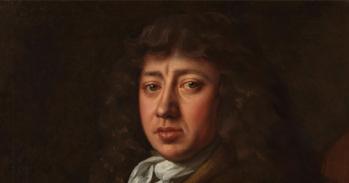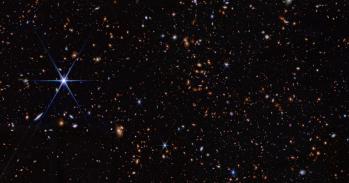
Mathematical research in Cambridge has a breadth that extends from the purest of theory to the most practical of applications.
Mathematical research in Cambridge has a breadth that extends from the purest of theory to the most practical of applications.
Mathematics lies at the centre of a vast range of practical and fundamental questions.
Professor Peter Haynes
Mathematics has been studied in Cambridge for much of the past 800 years. Its history includes Robert Recorde, credited with inventing the equals sign in the 16th century, and Sir Isaac Newton, the great 17th-century mathematician, physicist and holder of the Lucasian Professorship of Mathematics.
Today, the Faculty of Mathematics comprises two Departments: Applied Mathematics and Theoretical Physics (DAMTP) and Pure Mathematics and Mathematical Statistics (DPMMS), both now housed in the magnificent £61.4 million Centre for Mathematical Sciences (CMS). Officially opened in 2005, the CMS has been designed to encourage synergy between the Departments and to exploit new possibilities for collaboration. ‘The new buildings are giving us the opportunity to learn and benefit from each other in a place that fosters creativity, ideas and the possibilities they represent,’ said Professor Martin Hyland, Head of DPMMS. ‘New research and teaching activities have begun, and more are sure to follow as old boundaries disappear.’
The complex comprises seven large pavilions grouped around a grass-roofed central building containing communal areas, lecture theatres and a laboratory. It also incorporates the Betty and Gordon Moore Library, named in honour of its benefactors, and the Isaac Newton Institute, which is a national and international visitor research centre.
Mathematics might be an historic subject for Cambridge, but it is also a discipline concerned with the modern world, as Professor Peter Haynes, Head of DAMTP, explained: ‘Mathematics lies at the centre of a vast range of practical and fundamental questions, whether it’s calculating the probability of risk, assessing change in our atmosphere, predicting avalanches or modelling viral epidemics.’
Earth and beyond
What makes sense of mathematical research is that it tells a story. For some mathematicians their stories derive from the real world and for others they come from the realms of abstract thought. Some of the most striking contrasts in mathematical process can be found in areas that, at their heart, are concerned with understanding the fundamental forces of nature.
On the one hand, some of the more applied aspects of research at the CMS are centred on the mechanics of fluids and solids. Mathematicians have joined forces with researchers in the Departments of Chemistry and Geography, forming the Centre for Atmospheric Science, to study the changing atmosphere. Similarly, the Institute of Theoretical Geophysics, a joint venture with the Department of Earth Sciences, is focusing on the physics of volcanoes, the Earth’s core and mantle, and sliding of the giant glaciers over land, which have applications in the oil industry and carbon capture. ‘In all of these areas, great skill is required in deploying the best mathematical techniques to interpret and simulate what we see in nature,’ said Professor Haynes. ‘Similar expertise is also being used in a host of other areas, such as noise from jet engines, improved ink-jet printing technology and nutrient transport in organisms.’
On the other hand, Professor Michael Green, newly elected Lucasian Professor, looks beyond Earth to develop theories of the Universe. This is the ‘Wild West’ frontier of mathematical physics, where imaginative ideas take shape about how the Universe might be. Professor Green is known internationally as a pioneer in string theory, which describes how the Universe is composed of tiny vibrating strings of energy. Like Professor Stephen Hawking, former Lucasian Professor and now a Director of Research in DAMTP, who discovered that black holes are not actually black, Professor Green maintains the Cambridge tradition of deriving radical ideas from elegant mathematics.
Purely maths
Some study mathematics because it is involved in everything around us, but others are simply fascinated by the subject itself. ‘Pure maths is driven by the endlessly absorbing rigour and beauty of compelling questions for their own sake,’ explained Professor Hyland. ‘The challenge comes when there is no obvious way to proceed.’
Some recent highlights, such as Dr Caucher Birkar’s work on the minimal model programme and Professor Nick Shepherd-Barron’s work on the Sato–Tate conjecture, involve ideas accessible only to the mathematical specialist. Other advances, such as those of 1998 Fields Medallist Professor Tim Gowers on Szemerédi’s theorem and Professor Ben Green on arithmetic progressions in primes, address problems that can be readily appreciated by the layman, even if the method of solution cannot. The common feature is that the solutions involve some remarkable new ideas. ‘Often, it is not so much the answer to the problem but the process of solving it that’s extraordinary,’ said Professor Hyland. ‘There is enormous value to mankind not only in developing the mathematical skills to solve significantly hard problems but also in simply adding to the body of knowledge about the mathematical universe.’
Reaching out
Mathematics is increasingly playing a significant role in many disciplines beyond the physical sciences. In biology, for example, enormous amounts of complex data are produced through genome sequencing, medical imaging, microscopy and other sources, and mathematics holds the key to exploiting these data. One of the newest developments within DAMTP is the Cambridge Computational Biology Institute (CCBI), which was set up to promote research requiring mathematical and computational biology. CCBI’s broad research interests stretch from microbial evolution to human disease.
Dr Julia Gog, for instance, specialises in the mathematics of infectious diseases, working with scientists in Departments including Pathology and Veterinary Medicine on the dynamics of diseases such as influenza. Dr Stephen Eglen models the development of the nervous system, in particular the structural and functional development of the visual system. Professor Ray Goldstein combines mathematics, physics and biology in theory and laboratory experiments to understand how self-propelled bacteria and algae move through fluids and what physical factors might have stimulated the evolutionary transition to multicellularity.
The Statistical Laboratory within DPMMS is concerned with probability and statistics, and their applications. It too addresses the increasing need for mathematical know-how within diverse fields of application, not only in biology, but also in engineering and finance. In 2006, the Engineering and Physical Sciences Research Council (EPSRC) awarded the University £2.3 million to develop core and methodological statistics and to foster stronger links to application areas. This resulted in the Cambridge Statistics Initiative, which today is providing the necessary bridge in Cambridge between statistical theory and practice.
Building the future
As well as progressing long-established research areas and developing fresh applications for mathematics, the CMS also has an eye on equipping the next generation of mathematical minds. The Cambridge Centre for Analysis, funded by EPSRC, opens at the beginning of the coming academic year to train PhD students in mathematical analysis. Directed by Professors James Norris and Arieh Iserles, this Centre for Doctoral Training is a major joint venture between DAMTP and DPMMS and will provide students with interdisciplinary research opportunities as well as broad training in vital aspects of modern mathematics.
It is this spirit of opportunity that embodies Cambridge mathematics, as Professor Hyland explained: ‘Part of our inheritance is the intellectual range that makes possible connections between seemingly unrelated phenomena and enables independent ideas to take flight. These opportunities will blossom here. In 50 years’ time, I believe that people will look back and say that moving the Departments together to form the CMS was a watershed for mathematics in Cambridge.’
For more information about research at the CMS, please visit www.cms.cam.ac.uk/
Major benefactors of the CMS: The Atlantic Philanthropies, Charles N. Corfield, Dr Martin C. Faulkes, The Märit and Hans Rausing Charitable Foundation, Garfield Weston Foundation and The Wolfson Foundation.
This work is licensed under a Creative Commons Licence. If you use this content on your site please link back to this page.





